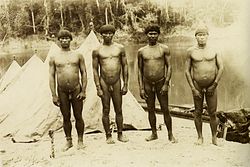Xingu peoples

|
|
| Total population | |
|---|---|
| 3,000 |
Aweti • Kalapalo • Kamaiurá • Kayapó • Kuikuro • Matipu • Mehinako • Nahukuá • Suyá • Trumai • Waura • Yawalapiti
Xingu peoples are indigenous peoples of Brazil living near the Xingu River. They have many cultural similarities despite their different ethnologies. Xingu people represent fifteen tribes and all four of Brazil's indigenous language groups, but they share similar belief systems, rituals and ceremonies.
The Upper Xingu region was heavily populated prior to European and African contact. Densely populated settlements developed from 1200 to 1600 CE. Ancient roads and bridges linked communities that were often surrounded by ditches or moats. The villages were pre-planned and featured circular plazas. Archaeologists have unearthed 19 villages so far.
Kuikuro oral history says European slavers arrived in the Xingu region around 1750. Xinuguano population was estimated in the tens of thousands but was dramatically reduced by diseases and slavery by Europeans. In the centuries since the penetration of the Europeans into South America, the Xingu fled from different regions to escape modernization and cultural assimilation. Nonetheless settlers made it up as far as the upper run of the Rio Xingu. By the end of the 19th century, about 3,000 natives lived at the Alto Xingu, where their current political status has kept them protected against European intruders. By the mid twentieth century this number had been reduced by foreign epidemic diseases such as flu, measles, smallpox and malaria to less than 1,000. Only an estimated 500 Xingu peoples were alive in the 1950s.
The Brazilian Villas-Bôas brothers visited the area beginning in 1946, and pushed for the creation of the Parque Indígena do Xingu, eventually established in 1961. Their story is told in a film, Xingu. The number of Xingu living there in 32 settlements has risen again to over 3000 inhabitants, half of them younger than 15 years.
...
Wikipedia
